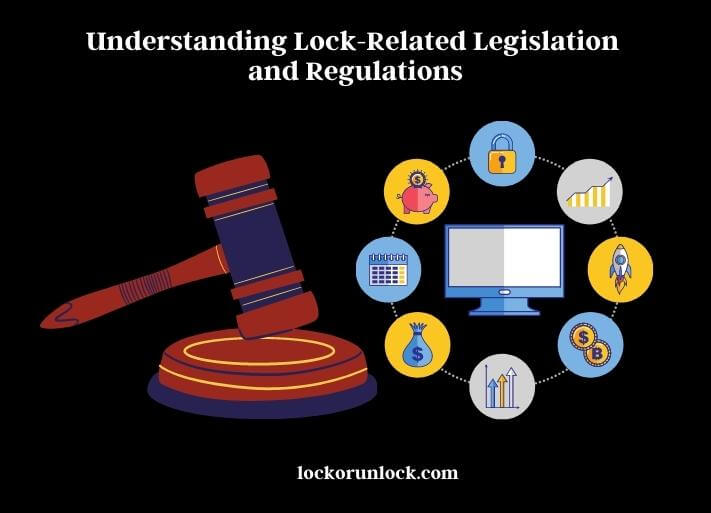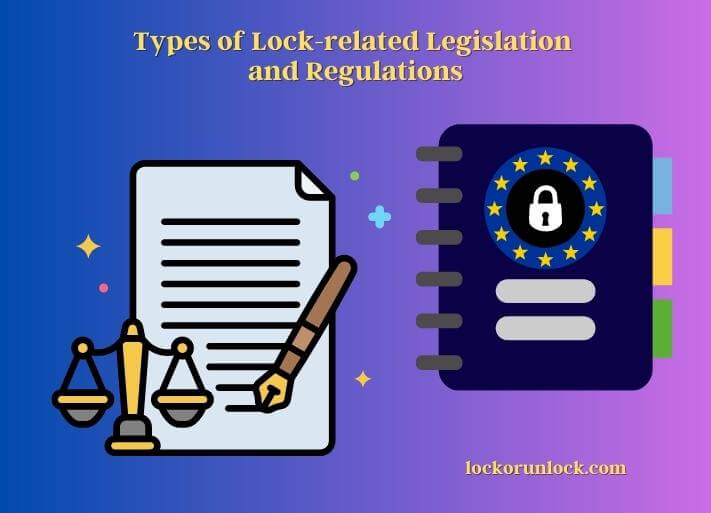Locks play a critical role in our daily lives. We rely on them to keep our homes, vehicles, and personal belongings safe and secure. From basic padlocks to high-tech biometric systems, locks provide us with a sense of control over our environment and help prevent theft and intrusion.

Using locks effectively requires more than just purchasing a sturdy padlock or high-security deadbolt. Locks can be subject to tampering or misuse, and their effectiveness can be compromised by factors such as wear and tear, improper installation, or inadequate maintenance.
To address these concerns, lock-related legislation and regulations have been developed to ensure that locks are used effectively and safely. These laws and regulations may require specific types of locks to be used in certain settings, establish standards for lock manufacturing and installation, or impose penalties for tampering with locks.
Lock-Related Legislation and Regulations
Lock-related legislation and regulations refer to laws and rules governing the manufacturing, sale, installation, use, and maintenance of locks and security devices. These laws and regulations aim to ensure that locks and security devices are safe, reliable, and effective in preventing unauthorized access to the property or protecting individuals from harm.
Lock-related legislation and regulations may include requirements for the design, testing, and labeling of locks and security devices, as well as rules for the licensing and training of locksmiths and security professionals. They may also address issues such as key control, access control, and the use of electronic security systems.
Examples of lock-related legislation and regulations may include building and fire codes, consumer product safety standards, and laws related to property crime and burglary prevention.
These regulations may be enforced by government agencies, such as the Occupational Safety and Health Administration (OSHA), the National Institute of Standards and Technology (NIST), or the Consumer Product Safety Commission (CPSC), among others.
Types of Lock-related Legislation and Regulations
Lock-related legislation and regulations can be implemented at different levels of government, including the national, state, and municipal levels. Each level has its own set of laws and regulations that govern the use, installation, and maintenance of locks.

National Level
At the national level, one example of lock-related legislation is the Federal Anti-Tampering Act of 1982. This law was enacted to prevent the theft of motor vehicles and requires manufacturers to install anti-tampering devices in vehicles or face penalties. The act also prohibits the sale of devices that are intended to bypass anti-tampering measures.
State-Level
State-level lock-related legislation may vary widely from state to state. Some states require locksmiths to be licensed or impose specific training or certification requirements. Other states may require certain types of locks to be installed in certain settings, such as rental properties or government buildings.
Municipal Level
At the municipal level, lock-related regulations may be specific to a particular city or county. For example, a municipal code may require landlords to install deadbolts on exterior doors or require that locks be rekeyed between tenants. Municipal codes may also regulate the use of locks in public facilities, such as parks or community centers.
The purpose of lock-related legislation and regulations is to ensure that locks are used effectively and safely.
Examples of Lock-related Legislation and Regulations
There are many examples of lock-related legislation and regulations at the national, state, and municipal levels. These laws and regulations serve to promote the safe and effective use of locks, while also addressing concerns related to security and privacy.
Federal Anti-Tampering Act of 1982
This law was enacted to prevent the theft of motor vehicles and requires manufacturers to install anti-tampering devices in vehicles or face penalties. The law also prohibits the sale of devices that are intended to bypass anti-tampering measures.
Practice of Locksmithing
At the state level, many states have laws that regulate the practice of locksmithing. These laws may require locksmiths to be licensed or certified, undergo background checks, or complete specific training programs. For example, in the state of California, locksmiths are required to obtain a locksmith license from the Bureau of Security and Investigative Services.
Certain Types of Locks
States may also have laws that require certain types of locks to be used in certain settings. For instance, the state of Florida requires certain types of locks to be installed on all exterior doors of rental properties. Similarly, the state of Texas requires specific types of locks to be used on firearms storage devices.
Municipalities
Municipalities may also have lock-related regulations that are specific to their jurisdiction. For example, some cities require landlords to install specific types of locks on rental properties or require that locks be rekeyed between tenants. Other municipalities may regulate the use of locks in public facilities, such as parks or community centers.
Compliance with Lock-related Legislation and Regulations
Compliance with lock-related legislation and regulations is essential to promote safety and security. Locks are an important component of security systems, and when used correctly, they can prevent unauthorized access and theft. However, when locks are misused or neglected, they can become ineffective and pose a security risk.
To ensure compliance with lock-related legislation and regulations, individuals and organizations should be familiar with the applicable laws and regulations in their area. This may involve researching state and local laws, consulting with locksmiths or security professionals, or seeking guidance from government agencies.
When installing or maintaining locks, it is important to follow manufacturer instructions and industry best practices. Locks should be properly installed, regularly maintained, and promptly repaired or replaced when necessary. This may involve inspecting locks for wear or damage, lubricating locks to prevent rust or corrosion, or replacing locks that have been compromised or broken.
In some cases, compliance with lock-related legislation and regulations may require the use of specific types of locks or security systems. For example, some states require that rental properties be equipped with deadbolts or other high-security locks. Compliance with these laws may involve installing new locks or upgrading existing locks to meet the required standards.
Individuals and organizations should be aware of the penalties for non-compliance with lock-related legislation and regulations. Depending on the severity of the violation, penalties may include fines, suspension of business licenses, or even criminal charges.
You have to know about the psychology of lock design and its impact on security. Read this article for A to Z information.
Benefits of Lock-Related Legislation and Regulations
Lock-related legislation and regulations provide several benefits to individuals, businesses, and society as a whole. Some of these benefits include:
Increased Security
Lock-related legislation and regulations require locks and security devices to meet certain safety and effectiveness standards, which can help ensure that they are reliable and effective in preventing unauthorized access to the property or protecting individuals from harm.
Reduced Crime
Regulations related to burglary prevention and property crime can help reduce the incidence of these crimes by making it more difficult for criminals to gain access to buildings or property.
Improved Safety
Regulations related to building codes and fire safety can help ensure that locks and security devices are installed and used in a way that does not pose a safety risk to individuals or property.
Consumer Protection
Regulations related to consumer product safety can help ensure that locks and security devices are safe for use and that consumers are not misled or harmed by false or misleading advertising or labeling.
Professional Standards
Regulations related to the licensing and training of locksmiths and security professionals can help ensure that these individuals have the knowledge and skills necessary to provide reliable and effective security services.
Challenges of Lock-Related Legislation and Regulations
Lock-related legislation and regulations can also pose several challenges for individuals, businesses, and society. Some of these challenges include:
Compliance Costs
Compliance with lock-related legislation and regulations can be costly, especially for small businesses and individuals who may not have the resources to invest in expensive security systems or hire licensed professionals.
Enforcement Challenges
Enforcement of lock-related legislation and regulations can be difficult, especially in cases where individuals or businesses may be intentionally violating the law or where regulatory agencies may lack the resources to conduct thorough inspections or investigations.
Rapidly Evolving Technology
As technology continues to evolve, lock-related legislation and regulations may struggle to keep pace, leading to gaps in regulation or outdated standards that may not adequately address new threats or emerging technologies.
Lack of Standardization
Lock-related legislation and regulations may vary widely across different jurisdictions or industries, making it difficult for businesses and consumers to navigate the regulatory landscape or ensure that they are complying with all relevant regulations.
Adversarial Relationships
Lock-related legislation and regulations can sometimes create adversarial relationships between businesses and regulatory agencies, with businesses feeling burdened by regulatory requirements and regulatory agencies feeling frustrated by noncompliance or pushback from businesses.
Conclusion
Lock-related legislation and regulations play an important role in promoting safety and security. Locks are an essential component of security systems, and when used correctly, they can prevent unauthorized access and theft. When locks are misused or neglected, they can pose a security risk.
At the national, state, and municipal levels, laws and regulations are in place to promote the safe and effective use of locks. These laws may require the use of specific types of locks, mandate training or certification for locksmiths, or impose penalties for non-compliance.
To ensure compliance with lock-related legislation and regulations, individuals and organizations should be familiar with the applicable laws and regulations in their area. They should also follow manufacturer instructions and industry best practices when installing and maintaining locks.
